Key takeaways:
- Local community networks build connections through shared experiences, fostering friendships and a sense of belonging.
- Strong communities enhance mental well-being in retirement, providing support systems that alleviate loneliness.
- Luxury retirement homes offer amenities that facilitate social interaction and engagement, making daily life more enriching.
- Creating sustainable programs, like gardening or book clubs, promotes ownership and deepens community ties through shared interests.
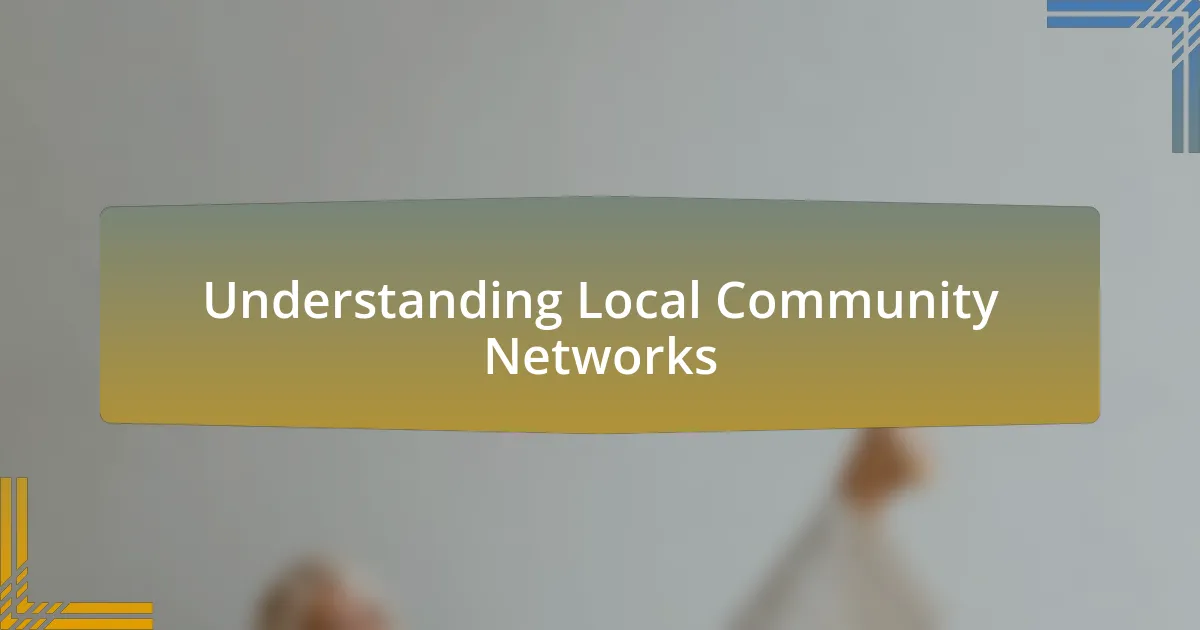
Understanding Local Community Networks
Local community networks are essentially the threads that weave individuals together, creating a fabric of support and connection. Reflecting on my experience, I remember the first time I attended a neighbor’s gathering; it was more than just a social event. It was a powerful reminder that community is built not just on proximity, but on shared experiences and mutual interests.
Have you ever noticed how a simple conversation can lead to new friendships? I experienced this firsthand when I joined a local book club. The initial hesitation quickly faded as we discovered our common passions, illustrating how even the smallest networks can blossom into something much larger through shared dialogues and activities.
It’s fascinating how local networks can evolve over time. Initially, ours started as a small group of residents looking to connect more deeply. As interactions grew—whether through potlucks or volunteer opportunities—we realized we were fostering not only friendships but also a sense of belonging. Isn’t it enriching to think how a simple desire for connection can transform into a vibrant community?

Importance of Community in Retirement
A strong community is vital in retirement because it cultivates a sense of belonging that can significantly enhance mental well-being. I recall a day when I volunteered for a community garden project. Watching seniors come together, digging deep into the earth while sharing stories, filled the air with laughter and camaraderie. Those moments demonstrated just how nourishing community connections can be for the spirit.
Consider how often we seek each other out for support during life transitions. Reflecting on my own experience, I remember feeling a bit lost when I first retired. The friendships I forged quickly became my lifeline, providing encouragement and companionship. This helped me realize that having a support system truly alleviates feelings of loneliness, turning challenges into shared journeys.
Community not only enriches our lives, but it also stimulates engagement and purpose, essential for a fulfilling retirement. I often think of the various clubs and activities in our local network—whether it’s art classes or gardening workshops. Each one has a way of igniting passion and creativity, transforming our golden years into a colorful tapestry of experiences. How many interests might lie dormant without the gentle push of a supportive community?

Benefits of Luxury Retirement Homes
One of the standout benefits of luxury retirement homes is the unparalleled access to top-notch amenities that promote wellness and leisure. I vividly remember visiting a luxury community where the fitness facilities were nothing short of impressive. The range of classes—from yoga to water aerobics—offered residents not only a way to stay active but also a chance to bond over mutual interests. Imagine starting your day with a refreshing swim alongside neighbors who quickly turn into friends.
Additionally, gourmet dining experiences are often part of the luxury retirement package, elevating everyday meals into enjoyable culinary events. I once joined a dinner at one such community where residents savored not just the exquisite dishes but also the great conversations that flowed around the table. It’s amazing how sharing a meal can strengthen relationships, don’t you think? Meals become more than just food; they become treasured moments of connection.
Another significant advantage is the enriched social calendar that luxury retirement homes provide. I recall attending a themed movie night organized by the staff. It was wonderful to see residents enjoying themselves, reminiscing about movies of the past, and making new memories together. This level of engagement not only combats loneliness but also fosters a lively environment where every day feels vibrant and full of potential. What activities might you be passionate about that could flourish in such a dynamic setting?
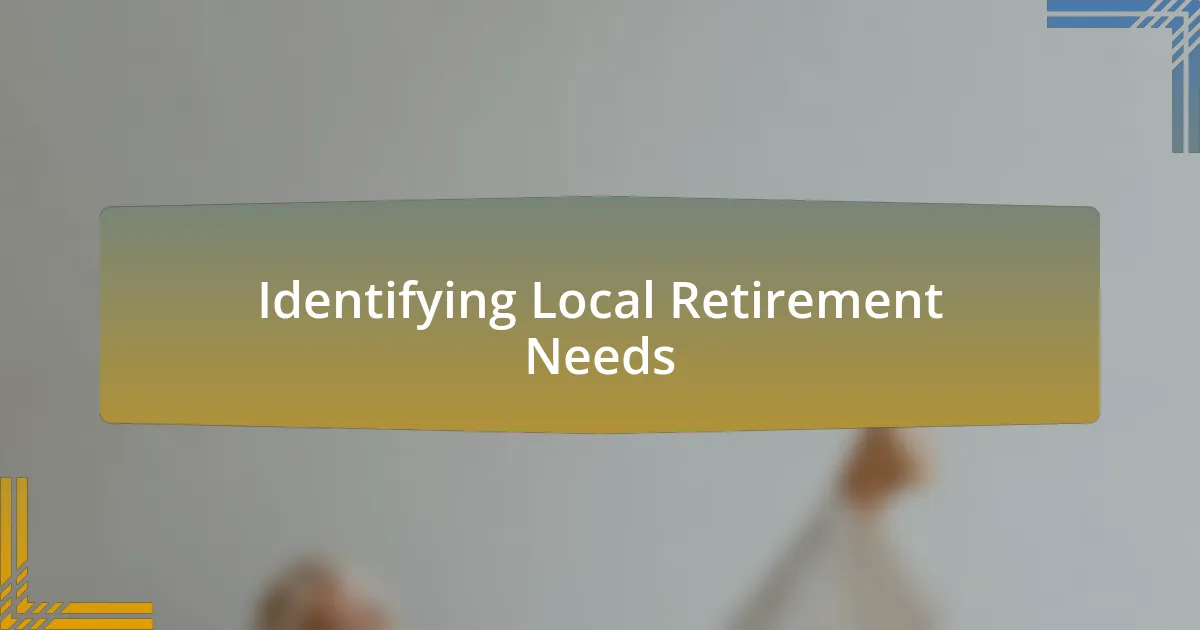
Identifying Local Retirement Needs
To truly identify the retirement needs of our local community, I found it essential to engage directly with potential residents. During a series of informal gatherings, I listened to stories that ranged from the desire for a closer connection to family to the need for specialized healthcare services. It’s fascinating how these personal insights revealed that most people prioritize not just comfort, but also accessibility to resources that make daily life easier and more fulfilling.
One evening, I attended a local community meeting where residents expressed their visions for an ideal retirement lifestyle. Some talked about the importance of outdoor spaces, like gardens for gardening enthusiasts or walking trails for those who loved nature. Each suggestion highlighted a universal desire: strengthening community ties. How often do we find ourselves feeling energized by shared experiences in our surroundings?
I also realized that cultural and social activities play a vital role in retirement satisfaction. A friend once shared how a lack of art and cultural programs in his previous retirement home left him feeling isolated. His enthusiasm for crafting and painting made me see the glaring gap in opportunities for creative engagement in our community. What if we could shape our local network to include art classes and social clubs that cater to these passions? The possibilities are endless when we truly listen and respond to what people want.
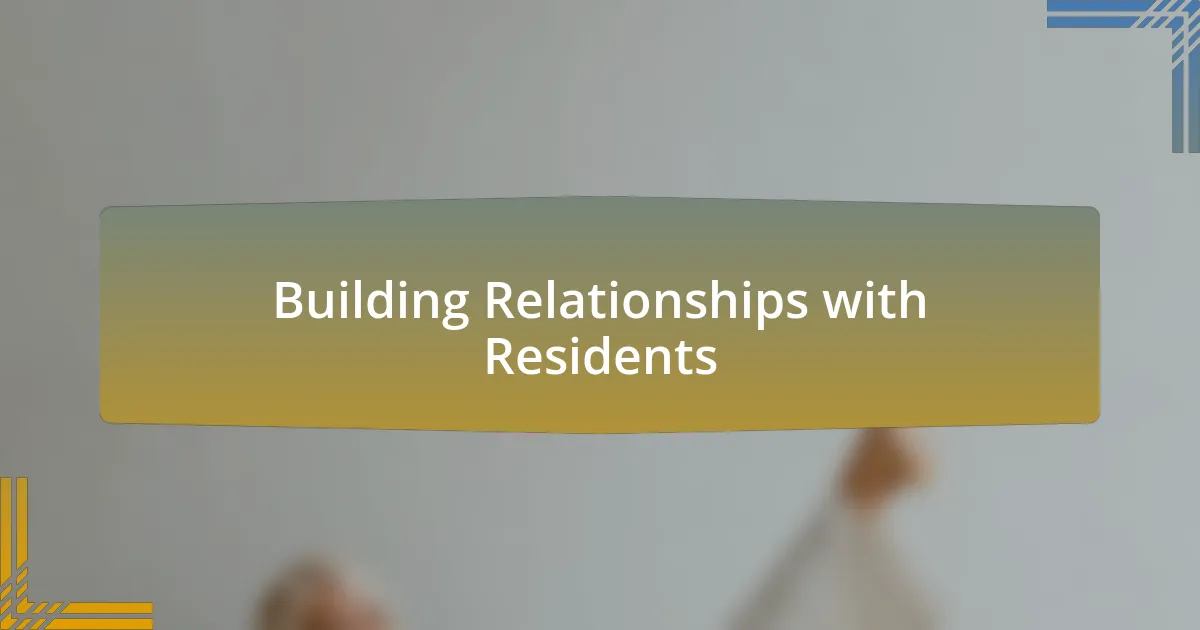
Building Relationships with Residents
Building relationships with residents is a journey that often begins with simple conversations. I remember my first open house event where I mingled with potential residents over cups of coffee. One woman, Alice, shared her favorite memories of family gatherings during the holidays. It struck me how these stories are not just reflections of the past, but stepping stones for creating a connected community here. How can we cultivate an environment where every resident feels valued, just like Alice?
As I got to know the residents better, I discovered the power of organizing shared activities. For instance, one afternoon, we hosted a friendly gardening workshop. It was a delight to watch neighbors collaborate and learn from each other, sharing tips and laughter. Those moments created bonds that extended beyond the workshop itself; they evolved into friendships. It made me realize that sometimes, a simple activity is all it takes to foster meaningful relationships.
One of my favorite experiences involved a potluck dinner that brought together residents from different backgrounds. I’ll never forget the joy on their faces as they shared their favorite dishes and stories. It underscored a critical truth: food has an incredible ability to connect people. How often do we recognize the cultural significance behind what we eat? By encouraging these personal exchanges, I found that our community blossomed into a vibrant tapestry of relationships and support.
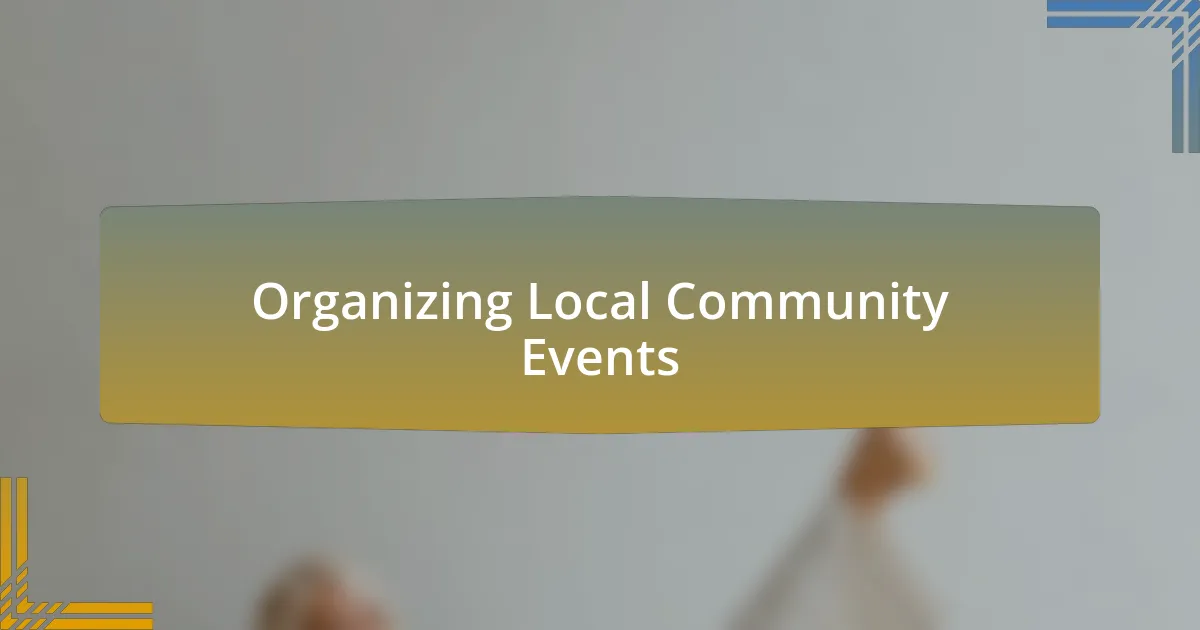
Organizing Local Community Events
Organizing local community events can sometimes feel daunting, but the rewards are immense. I recall coordinating a themed dance night, inspired by the classic ballroom events of bygone eras. Watching residents, many of whom initially hesitated to join in, step onto the dance floor with sheer joy was a transformative experience. It made me wonder: how often do we underestimate the ability of a simple gathering to spark joy and rekindle passions?
During the planning of an arts and crafts fair, I was pleasantly surprised to see the enthusiasm grow among residents. Many came forward, eager to showcase their talents, from painting to woodworking. Their pride in sharing personal creations sparked delightful conversations and ignited new friendships. I learned that giving residents a platform to express themselves could empower them to step out of their comfort zones. How can encouraging self-expression through community events reshape our perception of belonging?
One unforgettable day, we organized a neighborhood picnic in the local park. The energy was palpable, with families bringing blankets, games, and homemade snacks. I saw seniors engage with younger residents in playful games, creating intergenerational connections I hadn’t anticipated. Everyone left with smiles and plans for future gatherings. I realized that these moments not only strengthen community ties but also create a legacy of shared memories. Could our future events be built around fostering these connections even more intentionally?
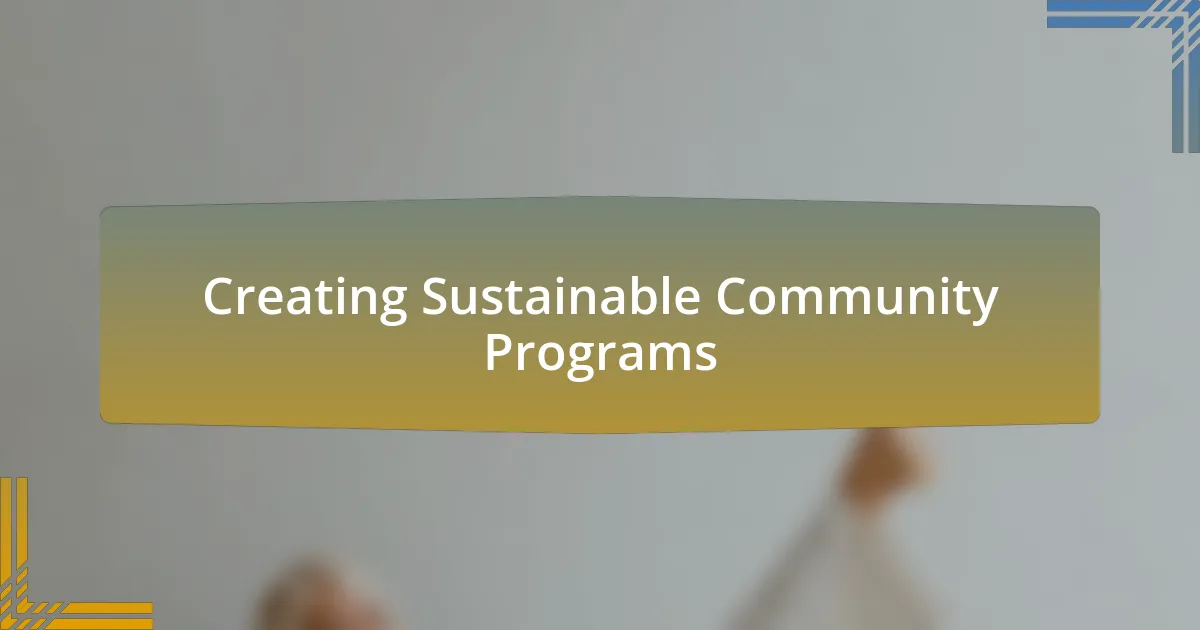
Creating Sustainable Community Programs
Creating sustainable community programs requires a vision that transcends mere activities. I remember when we initiated a gardening club, not just for the enjoyment of growing plants but with the goal of cultivating a sense of ownership among residents. Seeing participants nurture their plots, develop friendships, and even share the bounty reminded me that community programs can thrive on shared interests and the satisfaction of tangible results. What happens when we discover that the act of planting seeds can grow into much more than just vegetables?
The real magic unfolded during our monthly book club meetings. Initially, I expected a quiet gathering, but the conversations led to a profound exchange of stories and life experiences. Residents began to share personal tales that echoed themes from our readings, transforming the club into a safe space for vulnerability and connection. This evolution made me appreciate the importance of thoughtful programming—how can we create an environment that nourishes both the mind and the spirit?
In my experience, collaborating with local businesses can bring a myriad of resources to our initiatives. When we partnered with a nearby café for a community recipe share, it turned into much more than just food. The café’s owner came to know our residents personally, enriching the dialogue and resulting in a thriving local network that supported each other. Can fostering these partnerships deepen our community connections and ensure that our programs have a lasting impact?